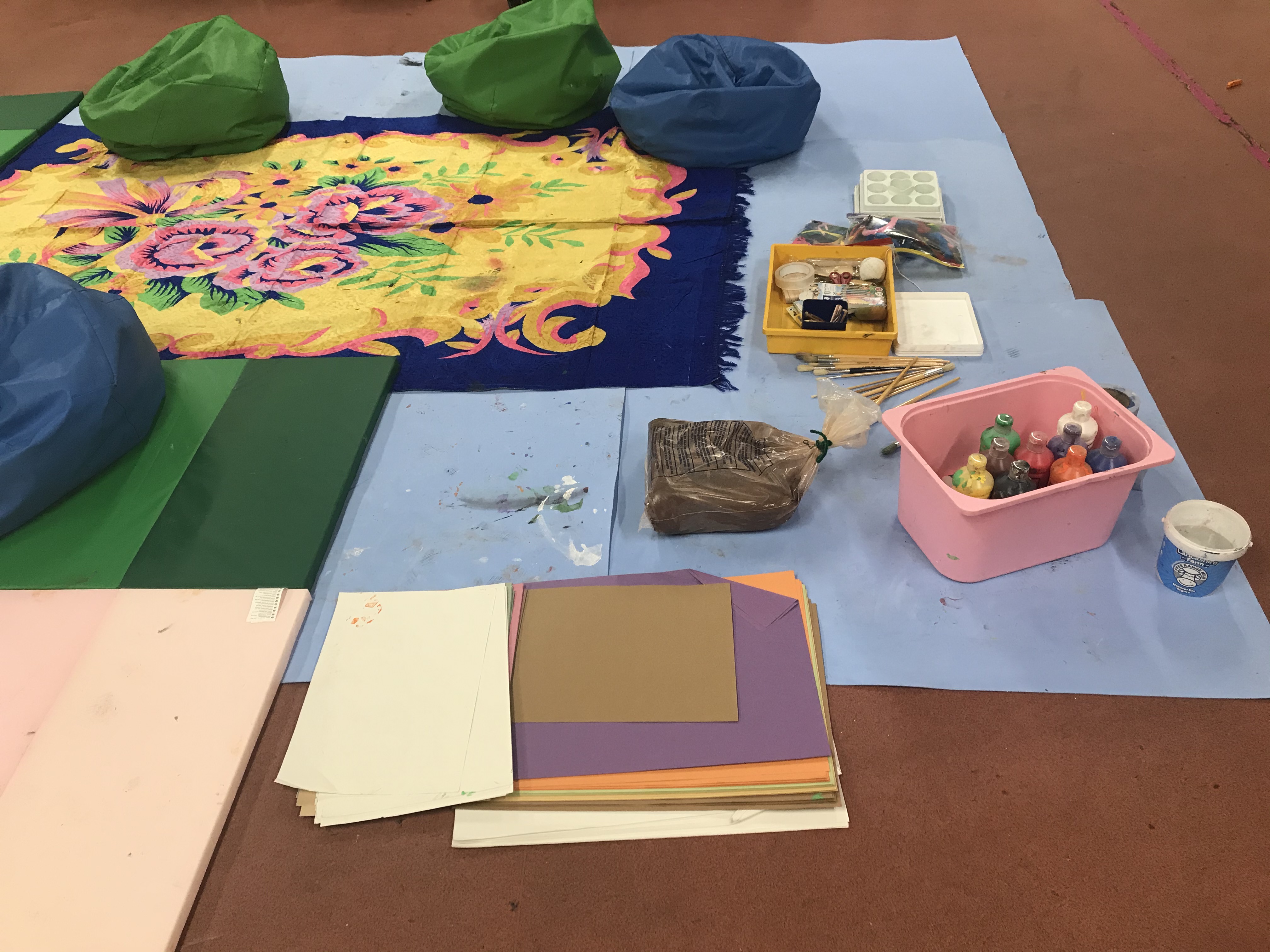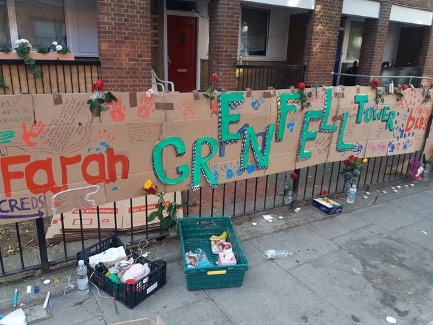
In response to the Grenfell Tower fire, art therapist Susan Rudnik founded Latimer Community Art Therapy (LCAT) in June 2017. Four years on, the Painting Together Group for parents with their babies and young children remains. Facilitated by art therapist Dean Reddick and Ros Taylor, the group is part of the larger ongoing therapeutic intervention for adults and young children in the local community. 
LCAT’s work, including the Painting Together group, is a fine example of responding inventively to the unique needs of a community.
Background to LCAT and the Painting Together group
Susan Rudnik has lived in the community for more than two decades. Susan set up the first art therapy space just three days after the fire. Several more soon followed.In her paper, Out of the Darkness: A Community led Art Psychotherapy Response to the Grenfell Tower Fire, Susan describes the organisation of the work and the therapists as, ‘giving a sense of control in the midst of the chaos’.
Over the years the therapy has taken different forms due to the changing needs of the community in the aftermath of this tragedy. Initially, art therapists established spaces on the streets where anyone in the community could participate. One of the early pieces of work was from a group of secondary school students who created a memorial to five of their friends killed in the fire. Susan describes one of the students ‘painstakingly drawing out the letters of Grenfell with precise detail. She sat for hours and when her work was finished said, “I feel like I have done something” ‘.
Within two weeks of the fire, there were art therapists in nine primary schools and two community spaces. A month after the fire, art therapy was provided in three more community spaces.
The nature of this impromptu art therapy
The usual boundaries of an art therapy provision were not possible. The therapy spaces were teeming with children. Susan describes what it looked like, ‘People spoke and cried together, trying to make sense of what had happened. The young children were playing games of trapping each other and then escaping. Some were jumping out of windows reliving what they had seen and heard over and over again.’
In the early days, none of the participants wanted to name their artwork. Susan sees this as a form of solidarity with those who were missing and unnamed. Similarly, no-one wanted a folder for their work. Susan says, ‘It just didn’t feel right to have a safe place when so many had violently and painfully lost theirs.’
As might be expected, the number of participants in the group therapy gradually reduced. The work now continues for small groups and individuals in the initial therapy space.
The standard principles of an art therapy can now be adhered to. Routines and boundaries are negotiated and settled upon; artwork is held in boxes and folders and locked in a cupboard; the door is closed. Susan explains, ‘The door is ok to be closed as the containment, so lost, is gradually able to be restored.’
Aims of the group
The Painting Together Group began in September 2019 and has been running on a weekly basis ever since. The group is attended by parents and carers with their babies and toddlers.
Its main aim is to foster and strengthen healthy adult-child attachments through the use of making art, play and talking. The context of making art can provide a safe and playful way to explore and express difficult or inaccessible thoughts and feelings.
Both making art and playing are equally important to the art therapy process.
According to Dean Reddick, who has worked in the EYFS for many years, the availability of art materials in such grave circumstances can be of invaluable help: ‘Their fluidity and malleability can be used to express and represent the trauma that is present in its many forms. Over time, the processing of that trauma can begin,’ he says. ‘Such is the theoretical premise of the work.’
The group focuses on the parent-child relationship, known as the dyad. Dean explains, ‘The dyad is the client in this approach. Having several dyads in one group makes for a rich environment. Parents can support each other, children can improve their social and play skills, parents and children have dedicated time together to pursue joint art and play activities.’
The Painting Together groups focuses on three main areas of mental wellbeing:
- Helping to improve parents’ and carers’ mental health and emotional wellbeing. The group is a space where they are safe in the knowledge that their own wellbeing is being given attention, time and space.
- Improving parent/carer-child relationships, parental sensitivity and parenting confidence. The therapists intervene sensitively in order to help nurture these things. Dean clarifies, ‘Focusing on the child's development, and helping the parents and carers understand it, is a key feature of our approach.’ As the parents get to know more about their child’s development and needs, they become more insightful about their behaviours and emotions.
- Facilitating a child-led play space where the children feel free to express themselves freely, no matter what they are trying to communicate. A professionally led context is important so that the participants can feel safe enough to be able to do this. The therapists can be supportive when difficult (and too-difficult) emotions and thoughts come to the fore.
Relating and building relationships through making art
Dean points out that, ‘Clay-work, painting and drawing can provide a focus for pleasurable and reciprocal communication and relating.’ He also explains how the process enables conflicts and difficulties to be addressed. These can be explored when materials have to be shared, turns have to be taken and mess has to be managed.
Towards the end of each session, the groups has a coming together where the dyads can share their work. ‘This gives the group as a whole the opportunity to reflect on their experiences and art works, says Dean.
What challenges have arisen?
As with many new innovations, practical issues can be the first hurdle. For the Painting Together Group, getting access to a suitable, uninterrupted space at the same time each week was tricky. The room needed to be big enough for the type of work being done: having a sink for washing up and a floor that would bear up to the mess, for instance.
Another challenge is one that is integral to any (therapeutic) intervention, that of referrals. This process has to be thought about very carefully.
Ros Taylor says, ‘Parents need to be “ready” to manage a group therapy approach. Parenting in front of professionals can feel exposing, especially if there are difficulties with the child’s behaviour.’ This form of group has particular tensions to do with giving attention to the various needs within the one group.
‘We have to try to work with the children’s needs; the parents’ needs; the dyad’s needs; the individual child, the individual parent and the group as a whole. It is a lot to bear in mind,’ Ros explains.
A further struggle has been getting fathers involved. Dean and Ros make sure that dads are mentioned in all invitations and use inclusive language in their communication, such as parent instead of mother.
In common with many organisations, the pandemic provided its own challenges. ‘We were on Zoom for the first lockdown,’ says Dean. ‘We distributed packs of art materials for families as all the shops were closed and online suppliers were running out.’ Since the summer holidays, the group has been able to meet in person in their usual space. Regulation social distancing and hygiene rules were adhered to among the adults. The children were not expected to wear masks or keep two metres apart.
LCATs numerous activities are thriving and continue to adapt to the needs of the community as time goes on. Susan Rudnik considers the considerable flexibility of the therapists to be one of the main reasons for the success of the work. She says, ‘They have worked in non-traditional settings during the most uncertain and darkest of times.’
This ability to meet the needs of the community is something that all of us can take something from, and certainly be inspired by.
Further reading and information
Rudnik, S. (2018) Out of the Darkness: A Community led Art Psychotherapy Response to the Grenfell Tower Fire. ATOL: Art Therapy OnLine, 9 (1)
Lavey-Khan, S. and Reddick, D. (2020) Painting together: A parent-child dyadic art therapy group. The Arts in Psychotherapy 70 (2020) 101687.
Winnicott, D. (1971) Playing and Reality. Tavistock Publications Limited.
More about LCAT:
LCAT is now a community interest company with 15 Art Psychotherapists practising with over 200 children, adolescents and adults per month. LCAT continues in three community spaces, 14 primary & secondary schools and 1 nursery. LCAT offers a therapy service at the V&A museum.
The Community Centre on the Henry Dickens estate, where LCAT began, remains at the heart of all services. Much needed activities are provided as well as employment and training for local residents. More information can be found at www.lcat.org.uk









